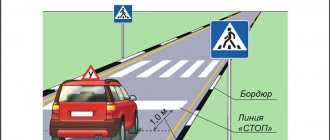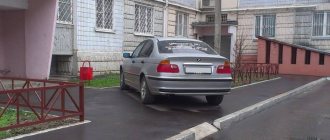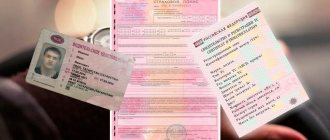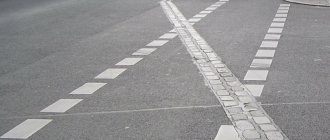Rules for crossing intersections for pedestrians
As always, let’s turn to the “mother of rivers”, the traffic rules. Here we scroll through the Rules to Chapter 4 “Responsibilities of Pedestrians”. Section 4.3 will be interesting.
4.3. Pedestrians must cross the road at pedestrian crossings, including underground and overground ones, and in their absence, at intersections along sidewalks or curbs. At a controlled intersection, it is allowed to cross the roadway between opposite corners of the intersection (diagonally) only if there are markings 1.14.1 or 1.14.2 indicating such a pedestrian crossing. If there is no crossing or intersection in the visibility zone, it is allowed to cross the road at right angles to the edge of the roadway in areas without a dividing strip and fences where it is clearly visible in both directions. The requirements of this paragraph do not apply to bicycle zones.
Yes, everything seems clear! Here we can draw the first conclusions:
— crossing diagonally is only possible at signalized intersections; - only if there is marking 1.14.1 or 1.14.2. (1.14.1, 1.14.2 - indicates a pedestrian crossing; marking arrows 1.14.2 indicate the direction of pedestrian movement;)
That is, if you suddenly need to cross diagonally at a signalized intersection, but there are no such markings, then you cannot cross diagonally! In fact, this will be a traffic violation. And if you commit violations, then punishments are quite possible...
Traffic police inspectors explained to South Sakhalin residents that it is forbidden to cross the road diagonally
15:27 March 12, 2021.
Yulia Belyaeva
Auto, Yuzhno-Sakhalinsk
Employees of the regional traffic police department conducted a raid on pedestrians. Crowds of violators crossed the intersection diagonally right in front of law enforcement officers.
The intersection of Sakhalinskaya and Lenin streets has long been on the lips of inspectors. Here, practically every minute, pedestrians violate traffic rules.
— Crossing diagonally at an intersection is permitted only if there is such a pedestrian crossing. There are no such things in our city, so for this violation there is an administrative fine of 500 rubles. Since July 2021, we have changed the traffic light phases in this area - three phases work for motorists and one for pedestrians,” said Tatyana Turovskaya, senior traffic police inspector for the Sakhalin region.
People are given 20 seconds to cross two fairly wide roads. Not enough, you say. The Sakh.com news agency correspondent decided to check for himself whether it was realistic to cover such a distance in the allotted time. It turned out that yes. But I had to speed up a little and even run. But Sakhalin residents prefer to run diagonally. They grab small children by the arms and rush headlong.
- They gave me one second to move, but I didn’t have time. We have to stand here and there. It’s your own fault,” shouted the grandmother, escaping from the traffic police officers.
Inspectors explain that when developing the city plan, traffic jams during peak hours were taken into account. If you increase the transit time on this section of the road, serious traffic jams will arise, of which there are already plenty in Yuzhno-Sakhalinsk. Only overpasses can solve the problem.
By the way, school No. 11 is located near this intersection. And the children, looking at the adults, also begin to cross the street diagonally.
Senior traffic inspector, police lieutenant Igor Dodunov explained that many citizens do not know about the ban on such a crossing. They are also knocked down by the waffle iron, which is actually intended for motorists.
“That’s why we conduct such raids.” It is important for us not to fine, but to explain to people that this cannot be done. But such events need to be organized more often to have an effect. In general, I think that it is necessary to draw clear markings or increase the transition time,” says Igor Dodunov.
In addition to this intersection, traffic police officers conducted raids in two more areas of the city - on Lenin Street, 149 and on Pobedy Avenue, 3. In total, inspectors conducted 26 explanatory conversations with pedestrians.
It should be noted that since the beginning of the year, 655 pedestrians have been brought to administrative responsibility in the region - 574 received a warning, and 81 people paid a fine. 12 attacks on Sakhalin residents were also registered.
News Agency Sakh.com
- 14650
- 152
- 9
- To favorites
- Send
- Error
- Share
- Link
Penalty for crossing the road diagonally at a controlled intersection
It's all very simple. Article 12.29 of the Code of Administrative Offenses of the Russian Federation is applied, that is, the same as for all other “sins” of pedestrians, part 1. In fact, the responsibility in the Code of Administrative Offenses of the Russian Federation regarding pedestrians, that is, their offenses, is not particularly developed; one might say this article is universal. Let's read.
1. Violation of the Traffic Rules by a pedestrian or a passenger of a vehicle shall entail a warning or the imposition of an administrative fine in the amount of five hundred rubles.
So, it's either a warning or a minimum fine. Something like this.
Fines for traffic violations
Administrative measures are taken against the violating pedestrian. They are defined in Part 1 of Article 12.29 of the Code of Administrative Offenses of the Russian Federation.
In this case, the violator will be limited to a warning or will have to pay a fine of 500 rubles.
At the same time, the article does not talk about the repetition of the violation. In fact, no measures other than a warning or fine are applied to the violator who has committed such an offense. The fine is set at a fixed amount. That is, there are no limits “FROM AND TO”.
| Did not find an answer to your question? Call a lawyer! Moscow: +7 (499) 110-89-42 St. Petersburg: +7 (812) 385-56-34 Russia: +7 (499) 755-96-84 |
Since such a violation is not classified as “serious,” the law provides for a “discount” on the payment of the fine. This is provided for in paragraph 1.3. Article 32.2 of the Code of Administrative Offenses of the Republic of Belarus. The violator will be limited to paying only half of the fine, provided that the funds are paid within 20 days, starting from the date of the decision on the violation, but not earlier than this fact is reflected in the special information base of the traffic police.
The current state of affairs when crossing an intersection under diagonals without markings
Despite the formal violation of the rules for crossing intersections diagonally, in most cases the police simply turn a blind eye to this. That is, this violation is not recorded, no explanatory work is carried out on it, and so on. That is, it is very difficult to “get” such a fine for crossing the road diagonally. Only if the scythe really hits the stone. However, now you will at least simply know about the rules of conduct at an intersection and about possible liability for violating such rules. Is it possible to pay a fine with a discount for crossing the road diagonally? Like many fines, but not all, the fine for crossing the road diagonally can be paid at a discount. That is, the violation is not “serious” and the effect of Article 32.2 of the Code of Administrative Offenses of the Russian Federation extends to Article 12.29 of the Code of Administrative Offenses of the Russian Federation. The fine can be paid with a 50 percent discount if you pay it within 20 days from the date of the decision, but not earlier than the moment the fine appears in the traffic police database.
Changes in traffic rules from April 15, 2015 - diagonal crossings
Government Decree No. 315 dated April 2, 2015 “On Amendments to the Traffic Rules of the Russian Federation” was published on the official Internet portal of legal information. The amendments were initiated by the Ministry of Transport of the Russian Federation. Changes to traffic rules come into force 7 days after official publication - from April 15, 2015.
There are many changes, they are interesting and controversial. The most noticeable ones are diagonal pedestrian crossings, marking parking pockets with longitudinal markings, the legalization of “VIP parking” - now the Rules contain a sign “only for holders of parking permits.”
Just as a year ago, attention was paid to cyclists; now they can move in a dedicated lane for public transport, and special signs have appeared on the roadway for the cyclist lane. The material consists of two parts. The main one, on changes in the text of the Rules and an additional one on new signs and markings. New definition of "Safety Island"
“Safety island”
is an element of the road arrangement that separates traffic lanes in opposite directions (including lanes for cyclists), structurally separated by a curb stone above the roadway or designated by technical means of traffic management and intended to stop pedestrians when crossing the roadway. The traffic island may include part of the dividing strip through which a pedestrian crossing is laid.
Everyone has heard the concept of “safety island”, but until now it has not been defined in the Road Traffic Rules
.
A formal change that does not alter the organization of the movement. Previously, pedestrians stopped on the median strip, but now they are allocated a special place on this strip. Changing the definition of "Bicycle Lane"
The designation of the bicycle lane on the roadway has been changed to
“Lane for cyclists”
- a lane of the roadway intended for the movement of cyclists and mopeds, separated from the rest of the roadway by horizontal markings and marked with sign 4.4.1 in combination with plate 8.14 located above the lane.
"Lane for cyclists"
- a lane of the roadway intended for the movement of bicycles and mopeds, separated from the rest of the roadway by horizontal markings and marked with sign 5.14.2.
A new sign 5.14.2 has been introduced.
"Lane for cyclists." To indicate a lane, it is no longer necessary to place a combination of two characters and always above the lane. It is also possible to place it on the edge of the roadway, in the same way as the sign “Lane for route vehicles.” Diagonal pedestrian crossings
Diagonal pedestrian crossing in Japan
4.3. Pedestrians must cross the road at pedestrian crossings, including underground and overground ones, and in their absence, at intersections along sidewalks or curbs. If there is no crossing or intersection in the visibility zone, it is allowed to cross the road at right angles to the edge of the roadway in areas without a dividing strip and fences where it is clearly visible in both directions.
4.3. Pedestrians must cross the road at pedestrian crossings, including underground and overground ones, and in their absence, at intersections along the sidewalks or roadsides.
At a controlled intersection, it is allowed to cross the roadway between opposite corners of the intersection (diagonally) only if there are markings 1.14.1 or 1.14.2 indicating such a pedestrian crossing.
If there is no crossing or intersection in the visibility zone, it is allowed to cross the road at right angles to the edge of the roadway in areas without a dividing strip and fences where it is clearly visible in both directions.
A new paragraph has been added to clause 4.3, which allows crossing the intersection diagonally. Please note the conditions under which such a transition is possible:
- Only at signalized intersections;
- Only if there are markings indicating a pedestrian crossing 1.14.1 or 1.14.2.
Pedestrians are NOT allowed to cross the road diagonally , as many headlines have claimed. Such an intersection is possible only with appropriate organization of traffic through the intersection.
Application of the definition of “Safety Island”
Once on the roadway (tram tracks), pedestrians should not linger or stop unless this is related to ensuring traffic safety. Pedestrians who do not have time to complete the crossing must stop on a traffic island or on a line dividing traffic flows in opposite directions. You can continue crossing only after making sure that further movement is safe and taking into account the traffic light signal (traffic controller).
If a pedestrian does not have time to cross the road, he must stop first at a traffic island or at a line separating traffic flows in opposite directions. It can not be in any other way. Perhaps it would be more logical to replace the preposition “or” with “and in case of its absence.” But we noted above that this change in traffic rules does not have much significance.
Red outline in additional section
Red outline in the additional section of the traffic light
The signal of the additional section is turned off or the red light signal of its outline is on
means prohibition of movement in the direction regulated by this section.
Another formal change; in practice, such traffic lights are already used. It would not be superfluous to reflect this fact in the Rules.
Parking method
12.2. It is allowed to park a vehicle in one row parallel to the edge of the roadway, with the exception of those places whose configuration allows for a different arrangement of vehicles. Two-wheeled vehicles without a side trailer may be parked in two rows.
Parking on the edge of the sidewalk bordering the roadway is permitted only for cars, motorcycles, mopeds and bicycles in places marked with sign 6.4 with one of the signs 8.6.2, 8.6.3, 8.6.6-8.6.9.
12.2. It is allowed to park the vehicle in one row parallel to the edge of the roadway. Two-wheeled vehicles without a side trailer may be parked in two rows.
The method of parking a vehicle (parking lot) is determined by sign 6.4 and road marking lines, sign 6.4 with one of the signs 8.6.1 - 8.6.9 and road marking lines or without them.
The combination of sign 6.4 with one of the plates 8.6.4 - 8.6.9, as well as road marking lines, allows the vehicle to be positioned at an angle to the edge of the roadway if the configuration (local widening) of the roadway allows such an arrangement.
Parking on the edge of the sidewalk bordering the roadway is permitted only for cars, motorcycles, mopeds and bicycles in places marked with sign 6.4 with one of the signs 8.6.2, 8.6.3, 8.6.6-8.6.9.
Useful clarification on the method of stowing the vehicle. You've probably come across spontaneous parking lots at an angle to the edge of the roadway. Until April 15, 2015, this method of installation was regulated by an unspecified configuration of the roadway and an unspecified “other” location. Given the scarcity of parking spaces, any pocket or widening of the roadway could be considered to allow "non-parallel" parking, even if such a pocket was narrow and not intended for such an arrangement. As a result, obstacles were created for traffic on the roadway.
In the new edition, a vehicle can only be parked parallel to the edge of the roadway, unless otherwise expressly stated:
- sign 6.4 with one of the plates 8.6.1 - 8.6.9 and road marking lines;
- sign 6.4 with one of the plates 8.6.1 - 8.6.9 without road markings.
- sign 6.4 and road marking lines;
Parking in a pocket marked with sign 6.4 with sign 8.6.5 and markings 1.1
Parking at an angle in a pocket marked with a sign 6.4 with a sign 8.6.5 without markings 1.1
In this situation, the question may arise: “Why is such parking incorrect? Condition - sign 6.4 + plate - fulfilled" Let's look again at the new paragraphs in clause 12.2 of the Rules.
The method of parking a vehicle (parking lot) is determined by sign 6.4 and road marking lines, sign 6.4 with one of the signs 8.6.1 - 8.6.9 and road marking lines or without them.
The combination of sign 6.4 with one of the plates 8.6.4 - 8.6.9, as well as road marking lines, allows the vehicle to be positioned at an angle to the edge of the roadway if the configuration (local widening) of the roadway allows such an arrangement. The method of setting in this situation is determined by the sign. There is no sign indicating the method of setting at an angle in the Russian Traffic Regulations. Plates 8.6.4 - 8.6.9 indicate the installation method - perpendicular to the edge of the roadway. The ability to park the car at an angle using such plates is indicated in the second paragraph of this amendment, which requires the fulfillment of the condition: “Sign 6.4 + plate 8.6.4 - 8.6.9 + markings.” This paragraph excludes the contradiction between plates 8.6.4 - 8.6.9 and markings applied at an angle to the edge of the roadway. Parking perpendicular to the edge of the roadway in a pocket marked with sign 6.4 with sign 8.6.5 without markings
Or, to park the car at an angle, the condition from the first paragraph “Sign 6.4 + markings” must be met when there is no sign on the sign.
Only if these conditions are met when organizing parking is it possible to park the car at an angle to the edge of the roadway. Parking in a pocket marked with sign 6.4 and markings 1.1
Parking in an unmarked pocket
Parking in a pocket marked only with sign 6.4
Parking in an unmarked pocket in violation of traffic rules
Please note that for parking at any angle to the edge of the roadway, the use of sign 6.4 is mandatory.
Cyclists are allowed to use the MTS lane
18.2. On roads with a lane for fixed-route vehicles, marked with signs 5.11, 5.13.1, 5.13.2, 5.14, the movement and stopping of other vehicles is prohibited (except for vehicles used as a passenger taxi , as well as cyclists - if the lane for route vehicles is located on the right
) on this strip.
A highly controversial amendment.
The good goal is to expand cycling routes. Imagine the simplest situation. The MTS lane, according to GOST, is marked with 1.1 markings and has a width of 3.5 meters: Bus and cyclist on the same lane
- A large bus catches up with a cyclist. Places for advance with a safe interval - no
- The opposite situation, a cyclist approaches a bus standing at a stop.
Both situations provoke a violation of traffic rules.
Attention, cyclists!
Please note that the privilege of driving in a dedicated lane for fixed-route vehicles, as in the case of allowing the movement of passenger taxis, is indicated only in Chapter 18 of the Rules. There are no privileges regarding the operation of signs and markings.
The requirements of signs 3.1, 3.2, 3.18.1, 3.18.2, 3.19, 3.27, 4.1.1-4.1.6 are mandatory for cyclists.
If entry into the MTS lane is prohibited, then it is prohibited throughout the entire area of the sign, regardless of where entry into it was made.
The statement is debatable, but avoiding responsibility is only possible hypothetically. In fact, this will require resources incomparable to the size of the fine. Based on materials from the site: ruspdd.ru
How to drive through diagonal markings correctly?
Driving and maneuvering on markings in the form of yellow diagonals is possible only if they can be completed before the prohibitory traffic light signal. This means that if there is a traffic jam at an intersection, the driver must evaluate whether he can pass the markings without stopping. If he stops on it, he becomes a violation of the rules, since he interferes with transversely moving traffic.
The rules stipulate the following exceptions , allowing you to stop at the markings when turning right or left:
- give pedestrians the opportunity to cross the roadway when the traffic signal allows them to move;
- give way to oncoming traffic when turning left.
Driving along diagonal markings is considered correct in the following situations:
- Without stopping, excluding pedestrians or oncoming cars when turning.
- If there is a congestion of cars on a marking, it is necessary to evaluate in advance the possibility of driving along it without stopping. If the maneuver fails, it is better to stop and wait for the traffic light to clear.
- To make a U-turn at an intersection, it is better to avoid the maneuver in busy traffic. You may not be able to complete it without stopping.
Therefore, you should follow the sequence of actions when approaching an intersection with diagonal markings:
- estimate the length of the markings, the number of vehicles on it and their speed;
- determine the time until the traffic light prohibits traffic (as a rule, at such intersections a device with a countdown is installed);
- make a decision to continue driving; if this is impossible without violating traffic rules, it is better to stop. This way you will avoid a fine.










